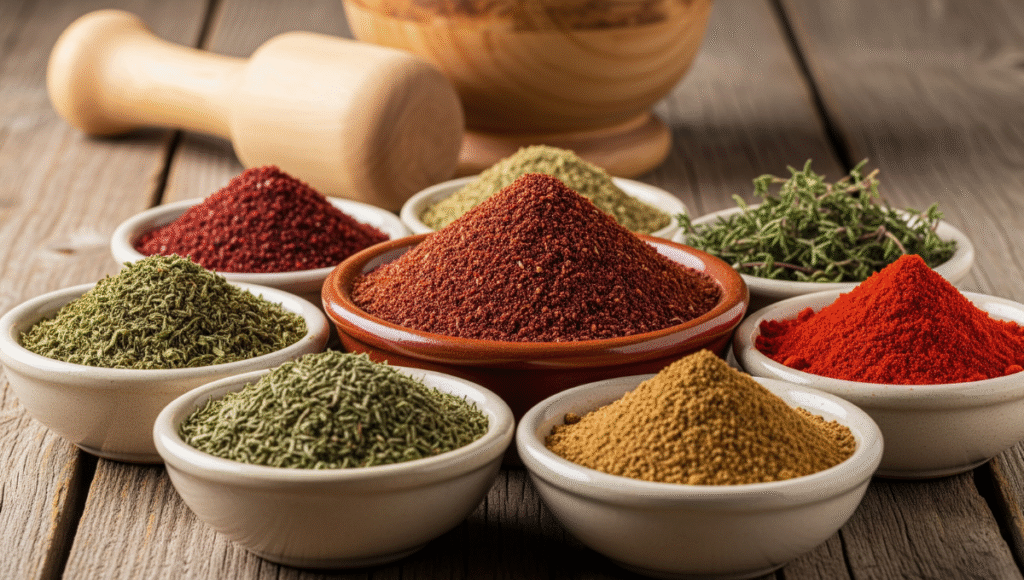Celebrated globally, Turkish gastronomy is distinguished by its bold tastes, fragrant spices, and a wide array of culinary customs. Among its many unique ingredients, Cevuri stands out as a distinctive and flavorful spice blend that embodies the essence of Turkish culinary artistry. But what exactly is Cevuri? How is it used, and what makes it special? In this article, we will delve deep into the origins, ingredients, uses, and cultural significance of this authentic Turkish spice mix.
The Origin and Cultural Significance of Cevuri
Cevuri is a traditional spice mixture deeply rooted in Turkish culinary history. Though it may not be as globally recognized as Za’atar or Sumac, Cevuri holds a special place in regional and home cooking across Turkey. Its origins trace back centuries, with recipes and blends passed down through generations, often varying slightly from one region to another.
In Turkish culture, spices are more than just flavor enhancers; they are an integral part of social gatherings, family traditions, and regional identity. Cevuri encapsulates this cultural richness by offering a blend that enhances dishes with aromatic complexity and authentic flavor.
What are the Ingredients of Cevuri?
The unique flavor profile of Cevuri comes from a carefully curated combination of herbs and spices. Although different versions exist, the fundamental components usually consist of:
- Sumac: Provides a tangy, lemony flavor and vibrant red color.
- Dried Mint: Adds freshness and a subtle herbal aroma.
- Dried Thyme: Contributes earthiness and warmth.
- Dried Oregano: Offers a savory, aromatic note.
- Cumin: Imparts warmth and depth.
- Paprika: Adds sweetness and color.
- Black Pepper: For mild spiciness.
- Salt: Enhances overall flavor.
Some versions may also include sesame seeds, dried chili flakes, or other regional herbs, depending on local traditions and personal preferences.
How is Cevuri Made?
The preparation of Cevuri involves drying and grinding the herbs and spices into a fine or coarse mixture, depending on intended use. Typically, the process includes:
- Drying the Herbs and Spices: Fresh herbs like mint and thyme are dried thoroughly to preserve their flavor.
- Preparation of powders: involves crushing dried ingredients with a mortar and pestle or utilizing a spice grinder.
- Mixing: The ground herbs and spices are combined in precise proportions to create a balanced blend.
- Storage: The mixture is stored in airtight containers away from light and moisture to maintain its aromatic qualities.
This traditional process ensures that each batch of Cevuri retains its authentic flavor and freshness.
Uses of Cevuri in Turkish Cuisine
Cevuri is a versatile spice mix used in various dishes and culinary applications across Turkey:
1. Seasoning for Grilled Meats and Vegetables
Sprinkling Cevuri over grilled kebabs, lamb, or roasted vegetables enhances their flavor with its aromatic notes.
2. Flavoring for Bread and Pastries
It can be mixed into dough or sprinkled on top of bread, simit (Turkish sesame bagels), or flatbreads before baking.
3. Dipping Sauces and Yogurt
Cevuri can be blended into yogurt or olive oil to create flavorful dips and spreads.
4. Salad Toppings
Adding a pinch of Cevuri to salads gives a tangy, herbal kick.
5. Marinades
It works well as part of marinades for meats and seafood, imparting a deep, layered flavor.
6. Soups and Stews
Incorporating Cevuri into soups and stews adds complexity and enhances the overall taste.
How to Incorporate Cevuri into Your Cooking
If you’re eager to try authentic Turkish flavors, incorporating Cevuri into your cooking is easy:
- Add a light dusting onto grilled meats or vegetables right before plating.
- Mix into olive oil or yogurt for a quick dip or spread.
- Add to homemade bread dough for a flavorful twist.
- Use as a seasoning for salads or roasted potatoes.
Because of its aromatic and tangy properties, Cevuri can elevate simple dishes into flavorful masterpieces.
Health Benefits and Nutritional Aspects
Many ingredients in Cevuri, such as herbs and spices, are known for their health benefits:
- Antioxidant properties: Herbs like thyme and oregano contain antioxidants.
- Anti-inflammatory effects: Spices like cumin and black pepper are known for their anti-inflammatory qualities.
- Digestive aid: Dried mint and thyme can aid digestion.
- Packed with vital vitamins and minerals: Herbs deliver crucial nutrients that support overall health.
Using Cevuri not only enhances flavor but can also contribute to a healthy diet when incorporated into balanced meals.
Where to Find or Make Cevuri
Authentic Cevuri can often be found in Turkish or Middle Eastern grocery stores, especially those specializing in spices. When buying, choose products made with natural ingredients and low levels of additives.
Alternatively, making Cevuri at home allows for customization according to your taste preferences. With simple dried herbs and spices, you can prepare a fresh batch and store it for months.
Conclusion
Cevuri is more than just a spice blend; it’s a reflection of Turkish culinary heritage, offering a harmonious balance of tangy, herbal, and savory flavors. Its versatility makes it an essential ingredient for anyone interested in exploring authentic Turkish cuisine or adding new dimensions to everyday dishes.
Whether you’re grilling, baking, or preparing traditional Turkish dishes, incorporating Cevuri will bring a burst of flavor that captures the essence of Turkey’s rich culinary traditions. Embrace this aromatic spice mix and enjoy the taste of authentic Turkish flavors in your kitchen!
